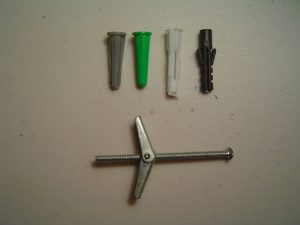Wall Anchor Types and Installing Wall Anchors
By Mark J. Donovan
|
|
Wall anchors are used for hanging pictures and other light weight items on walls where there are no wall studs. Wall anchors are designed for supporting hanging screws that would otherwise rip out of the drywall due to the weight of the object they are supporting. Installing wall anchors is very easy to do.
There are a few different wall anchor types to choose from. There are also numerous sizes associated with each wall anchor type. Selecting the right wall anchor type is mainly about understanding the weight and use of the object you plan to hang on the wall. Plastic Wall Anchors The most common wall anchor type is the plastic wall anchor. |
Plastic wall anchors look similar to a screw, however they have a hollow center where the screw is fastened into. Plastic wall anchors come in a variety of sizes. They are meant for hanging light objects on drywall walls such as small pictures and decorations.
To install a plastic wall hanger first drill a pilot hole into the drywall that is slightly smaller than the diameter of the plastic wall anchor.
Then gently tap the plastic wall hanger into the hole using a hammer until it is flush with the surface of the drywall.
Then use a screwdriver to screw in the screw. As the screw is screwed into the plastic wall anchor, it expands a little on the backside of the wall anchor to create some friction for holding the screw tightly in place.
Then install the hollow wall anchor into the hole, and while holding the anchor in place with one screwdriver or needle nose pliers, screw in the screw with another screwdriver. As the screw is threaded into the hollow wall anchor, the back side of the anchor will begin to flare out and snug up against the back side of the drywall.
| Toggle Bolt Anchors
A toggle bolt anchor works similar to the hollow wall anchor, however a toggle bolt is capable of holding slightly more weight. Toggle bolt anchors are also useful in applications where the wall hanging is frequently handled, e.g. a small bathroom towel rack. A toggle bolt wall anchor has a pair of metal wings that are spring loaded. To install a toggle bolt, drill a pilot hole that is just slightly larger than the maximum width of the wings when they are folded up around the bolt. |
 |
Next, remove the bolt from the wing assembly and slide a wall mounting bracket onto the bolt. Then thread the bolt back into the wing assembly.
Now squeeze the toggle wings together and push them and the end of the bolt through the pilot hole. Once the wings have been pushed through the pilot hole they will spring open.
Simply tighten up the bolt and the wings will flare up snuggly against the back of the drywall. Once the toggle bolt anchor has been fastened into place the wall hanging can then be attached to the wall mounting bracket.
For information on repairing a large drywall hole, see the “How to Repair a Large Drywall Hole” Ebook from HomeAdditionPlus.com. The “How to Repair a Large Drywall Hole” Ebook provides step-by-step instructions on how to repair your damaged wall so that it looks as good as new.
See HomeAdditionPlus.com’s Drywall Calculator
Related Information
- Toggle Bolt Wall Anchors
- How to Fix Peeling or Bubbling Drywall Tape
- Tip on Fastening Drywall to Ceilings
Additional Drywall Installation Resources from Amazon.com
 |
 |
Free Home Addition Price Quotes with No Obligation!
Fill out our 3-5 minute quick and easy form, and receive a free price quote on a house addition from one of our prescreened and licensed home addition contractors. This process is free and there is no obligation to continue once you receive your house addition price estimate.

